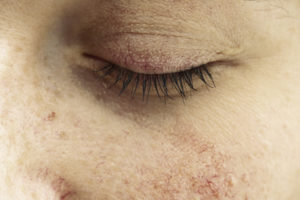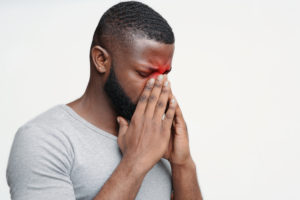Eyelid Dermatitis
 An itchy, red, and scaly rash over the eyelids is a very common presentation of a type of contact allergy. This condition is termed eyelid dermatitis and describes inflammation of the skin over the eyelids. It may be in fact a local manifestation of a generalized disorder called atopic dermatitis (i.e., eczema).
An itchy, red, and scaly rash over the eyelids is a very common presentation of a type of contact allergy. This condition is termed eyelid dermatitis and describes inflammation of the skin over the eyelids. It may be in fact a local manifestation of a generalized disorder called atopic dermatitis (i.e., eczema).
Eyelid dermatitis is usually seen in adults and teenagers and is less common in younger children. Both men and women can have eyelid dermatitis, but women greatly outnumber men in most studies of patients presenting with eyelid dermatitis. Both right and left sides are usually affected and both upper and lower eyelids are generally involved at the same time.
Causes:
The eyelids are a sensitive site due to the thinness of the skin and the potential increased penetration of allergens and irritant through this thin skin. Frequently, eyelids may be the only site affected by contact dermatitis. Interestingly, eyelid dermatitis may be the only manifestation of contact dermatitis to hair care products, even in the absence of a coexisting eruption on the scalp. Nail care products and other allergens may be transported from the hand to the eyelid area and may cause isolated eyelid dermatitis in the absence of hand dermatitis.
Allergic contact dermatitis – Allergens found to cause allergic contact dermatitis (ACD) on the eyelids may include metals (e.g., nickel, gold), fragrances, preservatives, and/or topical antibiotics.
Gold is a common cause of eyelid dermatitis. Exposure to gold occurs from jewelry on the hands or ears and perhaps is worsened by concurrent use of mineral-based cosmetics or sunscreens. Nail polish, particularly those made from acrylates, is often an overlooked cause. Eye drops containing antibiotics such as gentamycin or neomycin, as well as preservatives are the culprits in many instances. Sensitivity to contact lens solution and/or eye glass frames may also play a role in certain individuals.
Airborne contact dermatitis – Some likely causes may include plant antigens (e.g., ragweed, aster, sunflower, chrysanthemum), wood allergens, plastics, rubber, glues, metals, industrial and agricultural dusts, and/or pesticides.
Protein contact dermatitis – These may include foods, pollen, animal hair, and/ or latex.
Irritant contact dermatitis – Irritants known to cause or exacerbate eyelid dermatitis may include soaps, preservatives, and/or fragrances.
Atopic dermatitis – Eyelid dermatitis may occur in patients with a history of childhood-onset atopic dermatitis and/or other atopic diseases, including asthma and seasonal allergies (i.e., allergic rhinitis, hay fever).
Seborrheic dermatitis – Seborrheic dermatitis is a chronic, relapsing form of dermatitis that has a predilection for nasolabial creases, eyelids, ears, scalp and chest.
Symptoms:
Redness, severe itching, burning, and a stinging sensation over the eyelids are the most common symptoms of eyelid dermatitis. The eyelids can also be swollen and excessive fissuring of the skin is frequently visible. In addition, crusting of the secretions may be seen over the eyelashes. Seborrheic dermatitis on the eyelids may appear scaly and waxier than contact dermatitis.
Eyelid dermatitis may wax and wane and sometimes exhibit a seasonal variation. Individuals may notice that airborne irritants, including plants, pollens, dust, and dander, may trigger or exacerbate the disease. Eyelid dermatitis may also flare with hay fever (i.e., allergic rhinitis) or allergic conjunctivitis, possibly related to chronic tearing or mechanical rubbing.
Diagnosis:
The diagnosis of eyelid dermatitis is made in most cases clinically, based on the characteristic appearance of the eruption, associated symptoms, and clinical history.
Patch testing – Patch testing involves applying appropriately diluted allergens to the skin, usually on the back for convenience, for 48 hours. The patch tests are then read at 48 hours and again at 96 hours, as reactions usually take 48 – 96 hours to develop. Positive reactions produce a patch of dermatitis at the application site of the offending allergen, which will appear as a red and possibly raised, vesicular, and even blistering area.
Any patient with eyelid dermatitis requiring ongoing treatment beyond 4 – 8 weeks should be strongly considered for patch testing to ensure the correct diagnosis. The most frequent sensitizers are nickel sulfate, fragrance mix, balsam of Peru, paraphenylenediamine (PPD), and thiomersal.
If patch testing is negative, or positive reactions are deemed not to be relevant to the current dermatitis, the diagnosis of “irritant” contact dermatitis should be considered.
A skin biopsy may be helpful if the diagnosis is uncertain and, in particular, to rule out connective tissue disease.
Management:
Skin care – Conservative initial management of eyelid dermatitis includes gentle skin care and avoidance of fragrances and other known irritants in personal care, hair, and facial skin care products. Bland, fragrance-free emollients, such as petrolatum, may be applied directly to the eyelids.
Avoidance of irritants and allergens – In patients with a confirmed diagnosis of irritant or allergic contact eyelid dermatitis, ongoing avoidance of irritants and allergens is the mainstay of therapy. The use of perfumes and aerosol hair sprays should be avoided.
Topical corticosteroids – As the eyelids exhibit the highest percutaneous absorption of the body, only low-potency topical corticosteroids are safe for short-term use on the eyelids. Note that in the setting of active dermatitis, where the skin barrier is broken, the absorption may be even higher. Low-potency topical corticosteroids can be used twice daily for up to 2 – 4 weeks. Keep in mind that the prolonged use of topical corticosteroids in the periorbital area may induce a number of adverse effects. Even with low-potency topical corticosteroids, the eyelids remain vulnerable to thinning and atrophy.
Topical calcineurin inhibitors – Topical calcineurin inhibitors (e.g., Protopic, Elidel) can be used as an alternative to topical corticosteroids for the treatment of eyelid dermatitis in individuals who require prolonged treatment (i.e., beyond 4 weeks). Topical calcineurin inhibitors are applied twice daily for 2 – 4 weeks or until improvement is noted, and then tapered. The treatment can be resumed if flare-ups occur. The use of topical calcineurin inhibitors can initially be limited by a burning sensation when applied to inflamed skin, which improves with ongoing use.
The board certified allergy doctors at Black & Kletz Allergy treat both adults and children and will answer any questions you have concerning eyelid dermatitis or any other allergic skin disorder. Black & Kletz Allergy has locations in Washington, DC, McLean, VA (Tysons Corner, VA), and Manassas, VA. We offer on-site parking at each location and the Washington, DC and McLean offices are also Metro accessible. There is a free shuttle that runs between our McLean office and the Spring Hill metro station on the silver line. If you would like to make an appointment with an allergist, please call us or alternatively, you can click Request an Appointment and we will respond within 24 hours by the next business day. Black & Kletz Allergy has been providing quality allergy care to the Washington, DC metropolitan area for more than 50 years.

